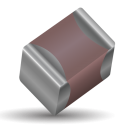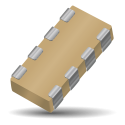Some Observations on Recent MLCCs Quality as Experienced in Europe Including Discussion of Two Types of Dpa Analysis Written By: Dr. Phil Ward Abstract: A study of the European MLC quality by two types of DPA analysis shows that the newer formulations of 2F4 (Z5U) are as reliable as C0G (NP0) and 2C1 (X7R) formulations. These newer 2F4 formulations have small grain structure and low porosity which perform excellent on life test at 2xRV and load humidity 85ºC/85% RH at RV.
Ceramic Capacitors
Reliability of MLCCs After Thermal Shock Written By: Bharat S. Rawal | Michael Childs | Allan Cooper | Bill McLaughlin Abstract: With increasing use of multilayer ceramic capacitors in surface mount applications, the understanding of thermal shock properties of these devices is becoming increasingly important. Of the various soldering techniques utilized in surface mount applications, including wave soldering, vapor phase and infra red reflow techniques, wave soldering imposes the most severe thermal stresses on the MLCs. To simulate this process, parts are often dipped in solder baths. It will be shown in this paper that properties like critical stress intensity factor K1C, thermal diffusivity, Young’s modulus and the chip geometry are important for understanding the thermal shock behavior of chips.
Reliability and Characterization of MLCC Decoupling Capacitors With C4 Interconnections Written By: Donald Scheider | Donald Hopkins | Paul Zucco | Edward Moszczynski | Michael Griffin | Mark Takacs IBM Microelectronics Division Hudson Valley Research Park 1580 Rte. 52, Hopewell Jct., NY 12533 John Galvagni AVX Corporation 2200 AVX Drive Myrtle Beach, SC 29577 Abstract: Multilayer ceramic (MLC) capacitors are composite structures made of alternating layers of ceramic (dielectric material) and metal (electrodes). The dielectric material is barium titanate-based ceramic and the electrodes are made of platinum. C4 (controlled collapse chip connections) technology [1] is used to provide multiple attachment points to substrates. A high dielectric constant of barium titanatebased ceramic helps to achieve a large capacitance/size ratio. The capacitance
Parameters Important For Surface Mount Applications Of Multilayer Ceramic Capacitors Written By: Bharat S. Rawal | Kumar Krishnamani | John Maxwell Abstract: With increasing use of multilayer ceramic capacitors (MLCs) in surface mount technology (SMT), the understanding of the mechanical properties and thermal stress resistance parameters of MLCs is essential for zero defect soldering and sub ppm failure rates. In this paper, various aspects of SMT including zero defect design, placement considerations, soldering techniques, thermal stress resistance parameters, and post solder handling are reviewed. Special emphasis is given to parameters responsible for thermal shock behavior of MLCs with review of the effect of overall component thickness, temperature gradients, and terminations of MLCs.
Multilayer Ceramic Capacitors Materials and Manufacture Written By: Manfred Kahn Abstract: The economical mass production of highquality, reliable and low-cost multilayer ceramic (MLC) capacitors requires a thorough understanding of the characteristics of the materials used, a knowledge of chemistry and electronics, as well as a high level of expertise in mechanical-equipment design and in-process technology.
Low-Voltage Performance of Multilayer Ceramic Capacitors Written By: N. H. Chan and B. S. Rawal Abstract: Extensive experiments and detailed analyses of the performance of multilayer ceramic capacitors used for decoupling and in other low-voltage, low-impedance applications discloses no degradation of insulation resistance in components without physical flaws. Capacitors with physical flaws show similar loss of performance at both low and high voltages.
Cracks: The Hidden Defect Written By: John Maxwell Abstract: Cracks in ceramic chip capacitors can be introduced at any process step during surface mount assembly. Thermal shock has become a “pat” answer for all of these cracks, but about 75 to 80% originate from other sources. These sources include pick and place machine centering jaws, vacuum pick up bit, board depanelization, unwarping boards after soldering, test fixtures, connector insulation, final assembly, as well as defective components. Each source has a unique signature in the type of crack that it develops so that each can be identified as the source of error.
Conduction and Failure Mechanisms in Barium Titanate Based Ceramics Under Highly Accelerated Conditions Written By: B. S. Rawal and N. H. Chan Abstract: Various mid-K and high-K barium titanate based laboratory compositions were studied to understand the conduction and failure mechanisms in multilayer ceramic capacitors (MLCs). These studies were utilized to establish the failure modes, the cause of failures, and determine the voltage and temperature acceleration factors. Current voltage plots were evaluated to study the endurance of the various ceramics under stress. These observations were employed to develop test conditions to screen commercial parts with one to two orders of magnitude lower failure rates and study production processes and types of ceramic materials to further improve the reliability of MLCs
Comparison of Multilayer Ceramic and Tantalum Capacitors Written By: Jeffrey Cain, Ph.D. Abstract: Engineers now have a choice between ceramic and tantalum when it comes to selecting capacitors with values between 0.1 – 22µF. As the ceramic material technology continues to advance, more and more capacitance is realized in the same case sizes compared to previous years. This paper will examine what devices are available and the trade off of using each of the technologies. The goal of this work is to help in selecting the proper device (tantalum versus ceramic) for a specific application.
Capacitor Array — An Integrated Passive Component Offering Benefits to the Automotive Sector Written By: Mark Stewart Abstract: By combining discrete capacitors into a multi-element package, AEC-Q qualified capacitor arrays offer automotive designers the opportunity to lower placement costs, increase assembly line output through lower component count per board and reduce real estate requirements.




